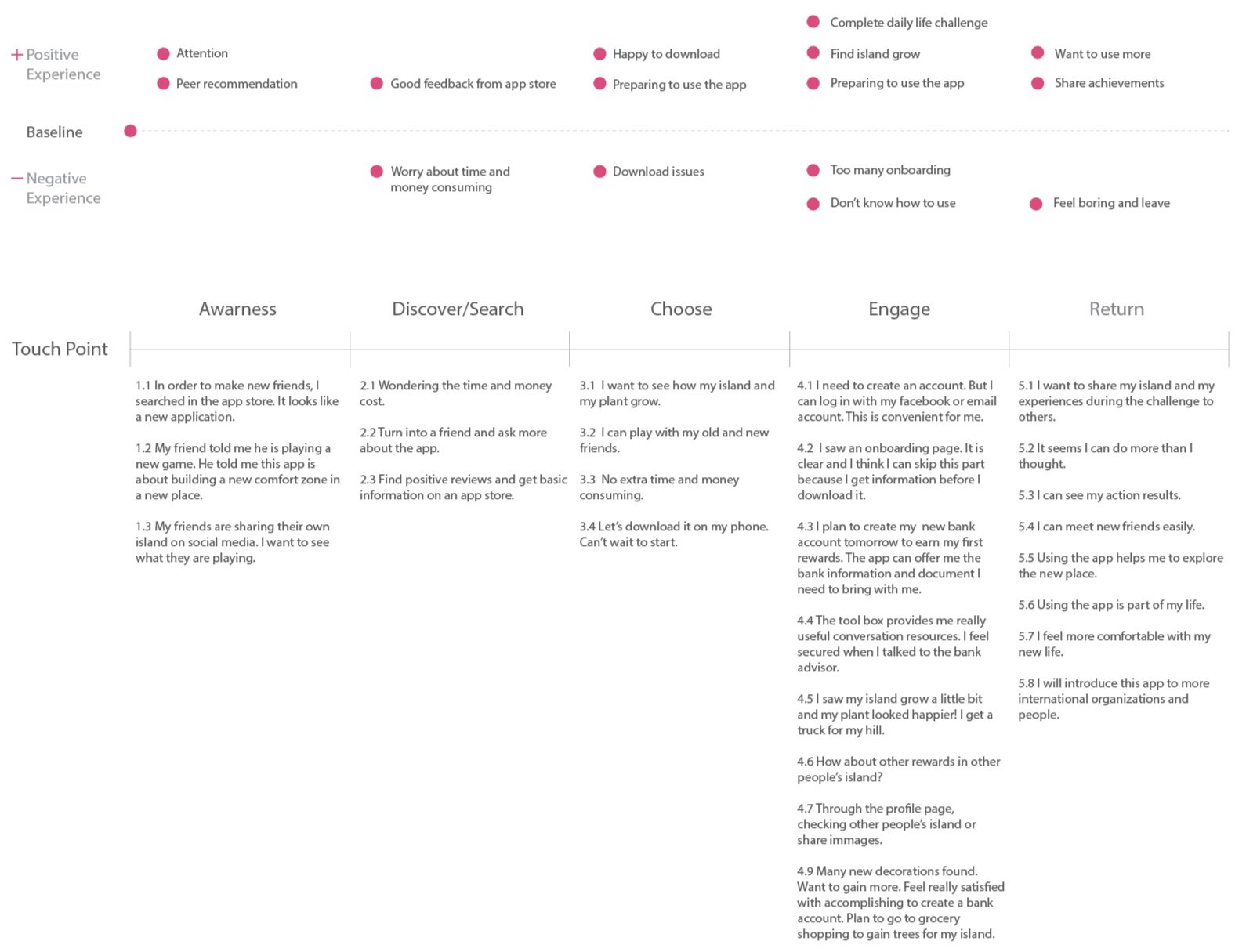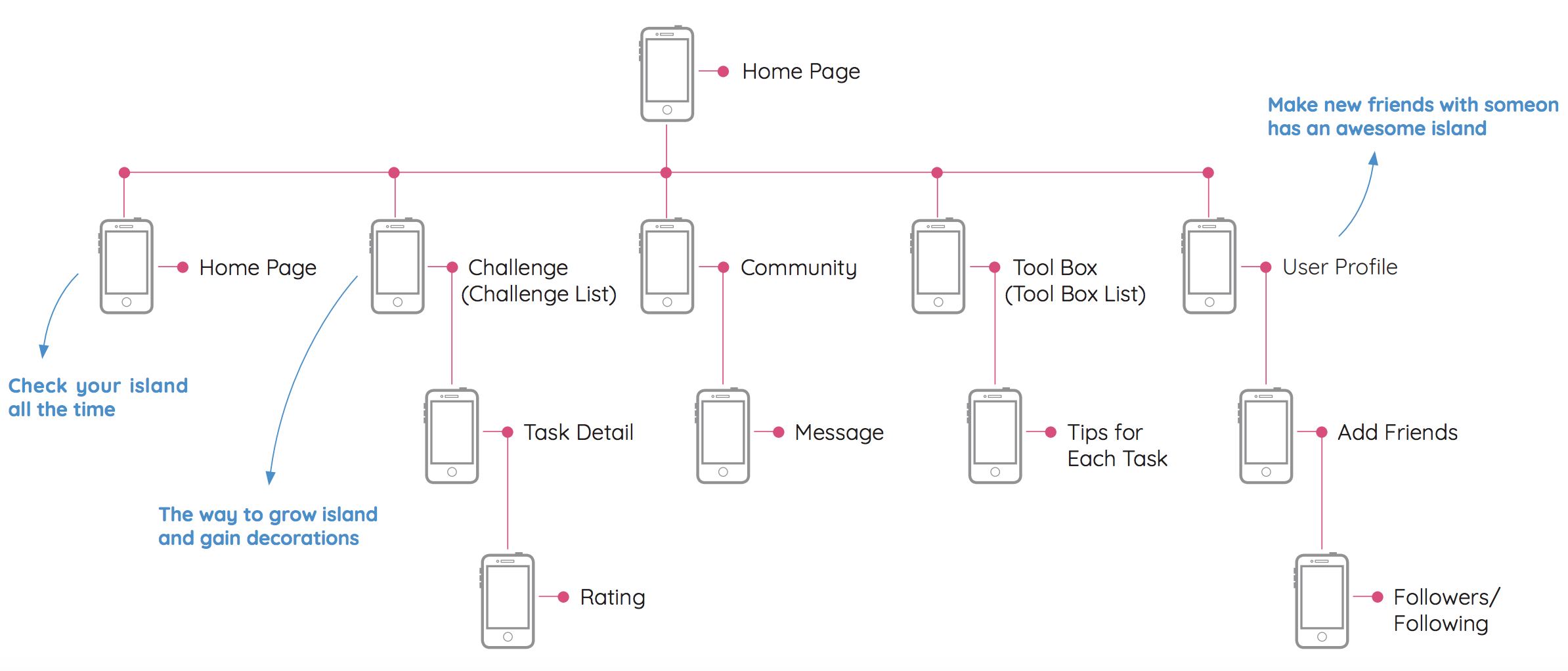TRANSPLANT
UI/UX & Game Design & App Design
01/
PROBLEM
1. THE SCENARIO IN DAILY LIFE
As an international student in the U.S, I am excited to embark on a new life. However, because my friends had experienced social barriers, such as having a hard time making new friends and facing issues expressing themselves, little by little, they started feeling lonely due to the lack of social life. One of them told me: "Actually, I can't find any motivation to explore the new place by myself!"
2. PROBLEM STATEMENT
Although there are many resources such as apps to make friends (meetup.com or language partner, etc.), people who move to a new place still have difficulty adjusting because of two main reasons: 1) self-consciousness and 2)different cultural backgrounds. In other words, newcomers will feel self-conscious because they are hyper-aware of their surroundings and slow to adjust. Different cultural backgrounds cause an absence of a sense of belonging in their lives.
02/
RESEARCH
1. LITERATURE RESEARCH
According to 2018 American Community Survey (ACS) data, the recent percentage of immigrants’ share of the total U.S. population is 13.7%.
Settling in a new country is difficult because newcomers have to step out of their comfort zone and leave their familiar environment. To adapt to new environments, international people must re-establish their social connections and formal routines. This process can be stressful.
Pain points
The Index of Life Stress(ILS) measures six areas of stress from Measures of Life Stress and Social Support Specific to an Asian Student Population (Bin Yang & George A, Clum, 1995).
2. SURVEY
I sent out a survey to 20 international students at Temple University to ask what kind of stress they have in their daily life? There are some scripts from the survey below:
3. SYNTHESIS
The MIT researchers discovered a simple neurological loop at the core of every habit, a loop that consists of three parts: A cue, a routine, and a reward. Rewards are powerful because they satisfy cravings (Duhigg, C., 2012).
Transplant is an app that uses small daily challenges such as opening a bank account or shopping for groceries to motivate international people to step out of their social comfort zone and manage the stressful adapting process. By using the app to alter a person’s everyday actions, newcomers can quickly acclimate to their new place and make new friends.
Here are the simple steps to encourage users:
1: Make people realize that their actions and breakthroughs are worthwhile
2: Provide positive incentives through virtual rewards and new friends
3: Break down adaption problems and make them easily manageable
4: Add social platforms to encourage people to make friends
4. COMPETITOR RESEARCH
Transplant provides the most meaningful features with daily challenges and social attributes to make newcomers build up their life. Three competitors in the iTunes app store are HelloTalk, Meetup, and IDareTo. Here are simple advantages and disadvantages for each competitor.
HelloTalk
Pros: The app can help foreigners to connect with native speakers.
Cons: The app mainly focuses on languages adaptation.
Meetup
Pros: The app benefits the peer-to-peer support of an empathetic online community.
Cons: The app only provides one-way information.
IDareTo
Pros: The app offers exciting and fun challenges.
Cons: The app only provides one-way information and no social attributes.
5. TARGET AUDIENCE
In the incubation stage, Transplant targets international students, including undergraduate, graduate, Ph.D. in the Philadelphia area; as starting users, their age ranges from 18 to 35, heaviest social media users. The international student population in the United States has dramatically increased during the past decades. In the 2017 and 2018 academic years, 1,094,792 international students enrolled in the U.S.
6. PERSONAS
03/
MAP
1. USER JOURNEY MAP
With all the information I collected. I decided to create a social gaming mobile application to solve the problem. I make this experience map to understand our product/service interactions from users’ points of view.
2. SITE MAP
The site map starts from the homepage, where there are four main functions to help the user accomplish daily challenges for upgrading level, obtaining special rewards, and expanding the island.
1. Homepage: The homepage shows the progress of the avatar system.
2. Challenge: Users take and track the progress of challenges. Some challenges integrate local shops and businesses, such as WaWa and Bank of America.
3. Community: Users make new friends discuss the solutions, and earn special awards.
4. Tool Box: Users can access resources such as keywords, dialog, and specific knowledge for the challenge.
5. User Profile: Users can post pictures, track the challenge's progress, and add friends.
3. USER FLOW
I sketched out a simple user flow through the app, from creating an account to achieving their daily challenges and obtaining their rewards.
04/
IDEATE
1. PAPER PROTOTYPES
I used paper prototypes to conduct user tests where the users could physically interact with the prototypes. Based on their tests, I worked with them and moved the order of the screens and discussed their experience and the issues or questions they had.
2. DIGITAL WIREFRAMES
I used Sketch to make low-fidelity wireframes of the phone screens. Later, I transferred screens to InVision Studio, where I implemented transitions and animations.
05/
BRANDING
After competitive research analysis, I started three mood boards to collect different inspirations. The branding language came from some digital iterations and pencil sketches. The branding included logos, colors, and the integration of a tagline.
COLOR & CHARACTERS
Four main colors fit into the inviting, accessible tone. Three characters are designed from ideation of “Transplant.“ Users are free to pick their favorite.
06/
FINAL
SCREENS
After completing wireframes and laying out the basic framework of the app, I applied color, typography, and imagery to get the app for IOS and Android systems for the design phase.
07/
PROTOTYPE
The final prototype for the app shows the user flow begins on the iPhone and shows the avatar system of the game, choosing a daily challenge and inviting their friends to play in a game of building up their island.
If you didn't see the above prototype, try this link: https://marvelapp.com/822g5c3
CREDITS
Art Director Bryan Satalino
Institution Tyler School of Art
© SandyChou 2022
















